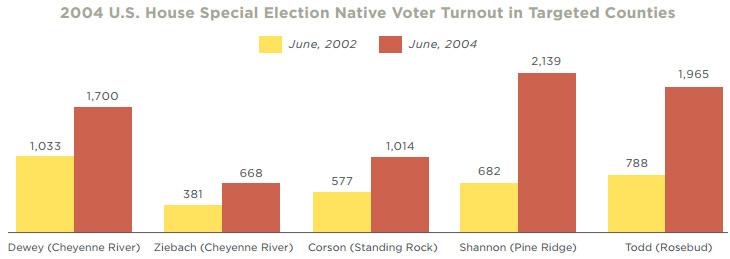2004: Recreating the Magic for the 2004 U.S. House Special Election
Now it was 2004. Native voters had flipped the outcome of the 2002 U.S. Senate race in South Dakota. But could they be counted on to turn out again for the unexpected U.S. House special election on June 1, 2004?
Barb and OJ formed Four Directions to lead Native voter turnout efforts in 2004 on the basis of valuable lessons they had learned in 2002:
- Identify talent during voter registration. Voter registration adds Native voters to the rolls, but more importantly, it helps Tribal leaders identify inspiring, influential Tribal members who may not be involved in traditional Tribal organizations.
- Train Tribal leaders for early vote and election day voting. Once future leaders are identified as potential organizers, they must be empowered with intensive trainings.
- Turn out Native voters with the right message. Educate Native voters with messaging that speaks to their issues.

In spring 2004, Four Directions launched an extensive voter registration and identification operation on the two largest Native American reservations in South Dakota, the Pine Ridge Indian Reservation and Rosebud Indian Reservation. For the growing population of urban Native Americans, Four Directions led a large turnout operation in north Rapid City, South Dakota. Smaller operations were undertaken in additional reservations in coordination with the Yankton Sioux Tribe, Standing Rock Sioux Tribe, and Cheyenne River Sioux Tribe.
On April 1, Four Directions began voter registration on the Pine Ridge and Rosebud Indian Reservations. As part of that effort, recruitment started for field workers and drivers for Election Day turnout operations. By the time the registration deadline closed, information for 1,731 new voters had been filed with the appropriate county clerks. Four Directions also recruited 310 Election Day drivers and 88 Election Day workers. As the chart below indicates, everywhere Four Directions worked, Native voter turnout dramatically increased — between 165 percent and 249 percent from June 2002 to June 2004.
In an election determined by only 3,005 votes, Four Directions brought more than 3,374 Native voters to the polls, ensuring the recognition of Native Americans as a force in the political landscape.
